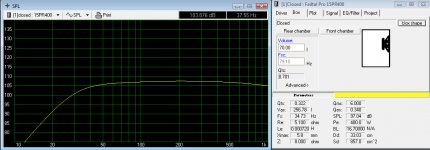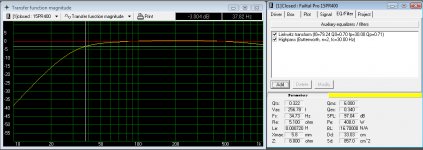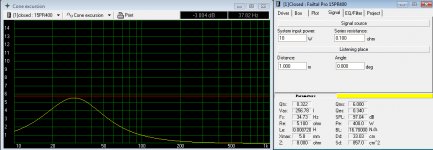This project looks interesting and it seems to meet the recommendations given in this thread ?
http://www.humblehomemadehifi.com/download/Humble Homemade Hifi_Calpamos.pdf
http://www.humblehomemadehifi.com/download/Humble Homemade Hifi_Calpamos.pdf
Yes, if you can accommodate that size. In fact I own that very same horn from P-Audio (JBL copy) and it sounds alright for regular applications. The diffraction slot should also not be a problem for your SPL requirements.
Those speakers are spoken as worthy of building from what I've seen discussed on this thread....I'd definitely let teh board guide you on a compression driver choice but that horn profile is stand out (jbl2380a)
I wanted to add, unless its been said...high efficiency drivers, in particular woofers, are known to have a tactile quality at low volume, that small inefficient speakers do not have.
I wanted to add, unless its been said...high efficiency drivers, in particular woofers, are known to have a tactile quality at low volume, that small inefficient speakers do not have.
I'm a big fan of that speaker.
I put the same 15" in a very rough sealed enclosure and it sounds excellent at low volumes. I really need to build something better for it 🙂 It's total overkill for my room.
A part of me does think that using something this dynamic only at low volumes is akin to driving a Ferrari in the car park though?
I put the same 15" in a very rough sealed enclosure and it sounds excellent at low volumes. I really need to build something better for it 🙂 It's total overkill for my room.
A part of me does think that using something this dynamic only at low volumes is akin to driving a Ferrari in the car park though?
Not even close....low distortion is low distortion (incase you haven't connected the dots between high dynamic potential and low distortion....)
Hi Camplo,
I hear what you're saying and agree (that's why I bought the drive units)
bh69 is listening at 6ft, at low volumes. Seems overkill but I didn't say I didn't like that idea 😉
I hear what you're saying and agree (that's why I bought the drive units)
bh69 is listening at 6ft, at low volumes. Seems overkill but I didn't say I didn't like that idea 😉
If you told I built my system (2- 18" 1-15" and a horn per side ) with nearfield (3ft) in mind would you hold it against me lol? only thing to do is make sure KA=2 or better for crossover to mid....I'm about 3ft away from a 65" that I game on as well lol...but as far as audio is concerned....I can only expect a very high direct energy vs indirect ratio...should make for good mixing and mastering...and gaming lol (I'm currently assembling)
Last edited:
Hey we all have our different requirements, such is the joy of diy, custom set ups.
I might toy with a nearfield set up some time soon myself.
I might toy with a nearfield set up some time soon myself.
I 'm searching for some "highend" amplifier for such sensitive speakers - a few watts is plenty, so A-class could be usable without too much "heating"
DIY Class-A 2SK1058 MOSFET Amplifier Project
Or maybe some tripath ? T2020 ? It can be battery powered for eliminating noise/EMI.
DIY Class-A 2SK1058 MOSFET Amplifier Project
Or maybe some tripath ? T2020 ? It can be battery powered for eliminating noise/EMI.
I use the 15pr400 in a 180l sealed box w/a low shelf boost of 12db. Out in the room they are 8-10db down around 35hz. Near a boundary they are almost flat to 35hz ... maybe down a couple db there. I doubt you'd see this in a 70l sealed box with this driver but I've never tried it either.
I prefer them out in the room as the FR is much flatter and they sound most natural. No EQ except for the low shelf.
Near boundaries, the response requires additional EQ in the lower midrange to sound right .. to me anyway.
They really come alive above 90db as well. Sound great in the midrange. I cross them @1khz.
At lower SPL, smaller sealed box might give you a bit more bass "presence" but not the extension.
I prefer them out in the room as the FR is much flatter and they sound most natural. No EQ except for the low shelf.
Near boundaries, the response requires additional EQ in the lower midrange to sound right .. to me anyway.
They really come alive above 90db as well. Sound great in the midrange. I cross them @1khz.
At lower SPL, smaller sealed box might give you a bit more bass "presence" but not the extension.
Dear bh69,
The MOSFET circuit shown does not use negative feedback and is mostly only an exercise for students to learn the basics of amplification. TA2020 is closed loop but does not include output filter (pre-filter feedback). Not recommended either, use only if nothing else is available.
Check out ICs such as LM4766, LM4780 etc (and many more). They need only simple connections, have in-built protection and have very low THD/IMD for your power levels.
You may rectify mains power as usual, for closed-loop amplifiers have a high PSRR and can reject any noise/ripple with ease. Stay away from any type of open-loop amplification.
All the best.
The MOSFET circuit shown does not use negative feedback and is mostly only an exercise for students to learn the basics of amplification. TA2020 is closed loop but does not include output filter (pre-filter feedback). Not recommended either, use only if nothing else is available.
Check out ICs such as LM4766, LM4780 etc (and many more). They need only simple connections, have in-built protection and have very low THD/IMD for your power levels.
You may rectify mains power as usual, for closed-loop amplifiers have a high PSRR and can reject any noise/ripple with ease. Stay away from any type of open-loop amplification.
All the best.
Last edited:
I use mine with minidsp hd, close to the wall, 100l-ish leaky, shoddy enclosure.
Messing about with REW I try equalize them to 20hz for fun. They shake the house with a 60W receiver.
Boundary reinforcement is no joke.
Currently crossing them over at 600hz to a pair of Klipsch quintets that I've removed the enclosure from, so an odd open baffle arrangement.
Messing about with REW I try equalize them to 20hz for fun. They shake the house with a 60W receiver.
Boundary reinforcement is no joke.
Currently crossing them over at 600hz to a pair of Klipsch quintets that I've removed the enclosure from, so an odd open baffle arrangement.
I doubt you'd see this in a 70l sealed box with this driver...
Didn't you notice the Linkwitz Transform for 30Hz ?
At lower SPL, smaller sealed box might give you a bit more bass "presence" but not the extension.
I put 10W in there, however at 2W the Linkwitz transform could be at 20Hz, just didn't want to exaggerate anything. Although amplifier power increases at lot due to the EQ, subwoofer won't be necessary.
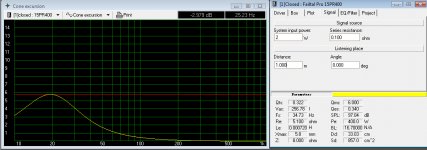
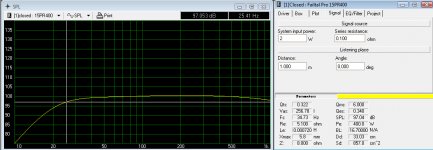
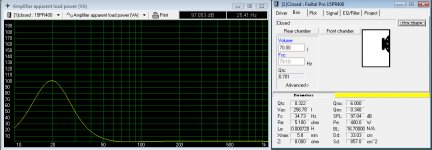
Last edited:
Check out ICs such as LM4766, LM4780 etc (and many more). They need only simple connections, have in-built protection and have very low THD/IMD for your power levels.
Thank you !
This amp looks very interesting - TAS2770 data sheet, product information and support | TI.com and with miniDSP Kits : miniSHARC Kit there is no DAC, whole chain is digital signal. Question is how to limit max volume/SPL.
rapsberry -> USB/SPDIF async converter -> miniShark -> I2S -> digital active speakers
rapsberry -> USB/SPDIF async converter -> miniShark -> I2S -> digital active speakers
Last edited:
Class AB is perfect, but 5V devices wouldn't make much power at low THD. Try to use a bigger chip (10-50W) at a fraction of its rated power to get better performance. This is especially true for the LF, as amplifier power could increase considerably as EQ and room compensation are applied (see #95).
Note that you generally pick your amplifier (and power supply) after finalising your speakers, box, EQ and all. That way you''ll know exactly how much power you need, making the process much easier and the results much more accurate.
Note that you generally pick your amplifier (and power supply) after finalising your speakers, box, EQ and all. That way you''ll know exactly how much power you need, making the process much easier and the results much more accurate.
Last edited:
Single ended amps with no feedback are enjoyed by many people. You can easily build this circuit and try it out. After all, this is DIY.The MOSFET circuit shown does not use negative feedback and is mostly only an exercise for students to learn the basics of amplification.
...
Stay away from any type of open-loop amplification.
- Home
- Loudspeakers
- Multi-Way
- DIY speakers for HQ low volume listening
